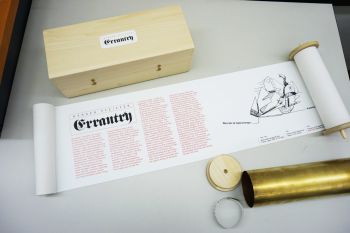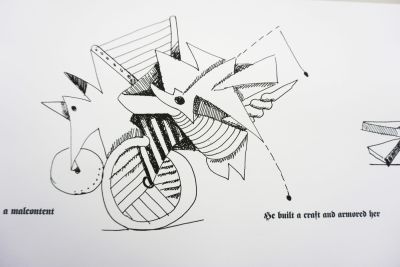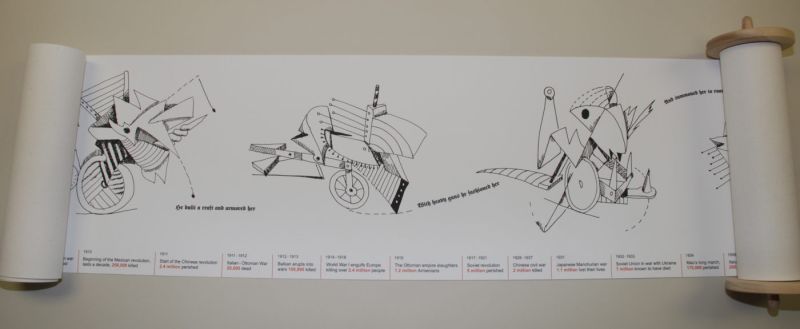"Errantry" by Werner Pfeiffer
Introduction

Errantry is an artist’s book by the German-American artist Werner Pfeiffer, published in 2008 by Pear Whistle Press. It is a 27-foot-long canvas scroll, featuring text and imagery predominantly inspired by a Tolkien poem and 16th-century woodcut prints, that is housed inside a deactivated military shell from 1943. The 12th copy in a limited edition of 52, this scroll is housed in the University of Pennsylvania's Kislak Center for Special Collections, Rare Books and Manuscripts [1]
Pfeiffer's provocative pairing of medium and message - using a repurposed instrument of 20th century warfare to chronicle that era's unparalleled death and destruction - epitomizes how artist’s books push the boundaries of the book form.
At the same time, the innovative format and socio-political content of this unusual work provide insight into the evolving role of artists as authors and the function of books as vehicles for creative expression and cultural critique.
Genre and Historical Context
Artist’s Books and Their History
While artists have been involved in the production of books in Europe since the early medieval period, such as the Book of Kells and the Très Riches Heures du Duc de Berry, most writers on the subject cite the English visionary artist and poet William Blake (1757–1827) as the earliest direct antecedent to the modern artist's book. Books such as Songs of Innocence and of Experience were written, illustrated, printed, coloured and bound by Blake and his wife Catherine, and the merging of handwritten texts and images created intensely vivid, hermetic works without any obvious precedents. These works would set the tone for later artist's books, connecting self-publishing and self-distribution with the integration of text, image and form. All of these factors have remained key concepts in artist's books up to the present day. [2]
Artist’s books are works of art that utilize the form of the book. They are artworks in book form, often created in small editions or as unique objects, that use elements of the book such as covers, bindings, typography and layout as part of their aesthetic expression. Emerging in the 20th century alongside avant-garde art movements, artist's books challenged traditional notions of the book, blurring boundaries between art object and reading material. Early examples include Stéphane Mallarmé's visual poem Un Coup de Dés (1897) and the Futurist books of Filippo Marinetti in the 1910s. The genre expanded in the 1960s-70s as Conceptual artists experimented with the democratic multiple, while others explored handcrafted volumes. The range of formats has continued to grow, from altered texts to sculptural bookworks to digital forms. [3] [4]
Artist’s Background

Werner Pfeiffer, a distinguished book artist, made Errantry. He emigrated to the US from Germany in 1961 and joined the art faculty at Pratt Institute in New York in 1969. He lives in Red Hook, NY, where he works as a sculptor, printmaker and painter. Pfeiffer’s work is typically characterized by strong political undertones and innovative formats.
Artistic and Intellectual Context
Werner Pfeiffer can be considered to belong to a lineage of artists who have used books to respond to the atrocities of modern war and oppression. For example, Italian artist Fortunato Depero, in his 1927 "bolted book" Depero Futurista', evoked the violence of World War I through aggressive typography, while John Heartfield's 1934 Krieg und Leichen (War and Corpses) photomontage indicted the Nazi regime. In repurposing a real military artifact, Errantry takes this tradition a step further. [5] [6] Beyond specific military references, Errantry reflects a late 20th-century surge of artist’s books critiquing consumer culture, mass media and the political status quo, such as Edward Ruscha's deadpan photo-books and Martha Rosler's collage novels of the 1970s.
Errantry also engages bookmaking traditions beyond the artist’s book per se. Its accordion-fold scroll evokes the vertical Chinese scrolls and horizontal Japanese narrative handscrolls dating back centuries. Pfeiffer's illustrative marginalia evoke medieval illuminated manuscripts as well as the extra-textual elements of 19th-century Victorian novels. His use of literary and historical sources, from Tolkien to Maximilian, encapsulates his attempt to adapt the past in a critique of the present.
In its combination of word and image, original artwork and repurposed text, codex and anti-codex formats, Errantry embodies the revolutionary hybridity of the artist’s book form. It links the genre's past to its present, using new technologies like digital printing to examine age-old themes of human conflict. Through both its innovative formats and critical content, Pfeiffer's work exemplifies how contemporary artist’s books act as sites of creative expression and socio-political intervention.
Contents and Organization
Scroll Contents
Errantry's 27-foot-long canvas scroll interweaves three main visual elements:

1. An adapted text of J.R.R. Tolkien's 1933 poem '"Errantry"'
2. Illustrations inspired by the militant characters and postures depicted in the 16th-century woodcut series '"The Triumphal Procession of Emperor Maximilian"'
3. A timeline of 20th-century wars, genocides, and their death tolls running along the bottom, based on 'historian Piero Scaruffi's research'
The title and text are based on a poem written by J.R.R. Tolkien in the 1930s. In his artist’s statement, Pfeiffer says, “The poem used in this scroll is an adaptation, with only two or three lines directly quoting the original. What is similar is the syntax, rhyme and meter of Tolkien’s writing.” The scroll begins with red text that provides context for both the poem and the illustrations. It introduces J.R.R. Tolkien's "Errantry" as the inspiration for the adapted text, explaining that while only a few lines are direct quotations, the scroll mimics the original poem's "syntax, rhyme and meter." This introductory text also credits the 16th-century "Triumphal Procession of Emperor Maximilian" woodcut series as the source for the scroll's militant imagery. [7]
Following the expository introduction in red text, the body of the scroll then unfolds into a sequence of unique illustrations reminiscent of a chimeric combination of mechanical machinery and war-ready soldiers. These illustrations are accompanied by lines of a poem from Pfeiffer's adapted text, printed in black ink using a bold, ornate font reminiscent of early printed books. The original Tolkien poem is considered a celebration of whimsy and “nonsensical adventure.” Pfeiffer’s text is more suitable for his work, adapting Tolkien's light verse celebrating a carefree wanderer into lines of “malcontent.”
“One of the dominant features in this document is the militant nature of many of the characters depicted, as well as their posture in parading their arms on horse, by carriage or on foot,” Pfeiffer writes in his artist’s statement. “The text and images are set against a chronology of war, conflict, and genocide in the 20th century.” [7]

Inspired by the "Triumphal Procession of Emperor Maximilian," a 16th-century series of 137 large-scale woodcuts commissioned by the Holy Roman Emperor to celebrate his achievements and legacy, these images evoke a sense of martial grandeur and pageantry. However, in the context of Pfeiffer's work, they take on a more sinister tone, serving as a visual manifestation of the violent and destructive impulses that have plagued human history. The stylized, almost caricature-like rendering of the figures adds to the unsettling atmosphere. This combination of text and image creates a visually striking and thematically coherent narrative that unfolds as the reader progresses down the scroll.
Running along the bottom of the scroll, Pfeiffer provides a timeline of wars and genocides in the 20th-century, describing the name of the event, relevant dates, and its location in black text. He highlights the death count of each event in red text, placing it in center focus to guide the viewer’s sense of mortality.
With its factual, succinct structure, the timeline provides a sobering counterpoint to the more fanciful elements above, grounding the work in the grim realities of the 20th century.
Organization and Materiality
Pfeiffer's inventive organization and use of materials underscore Errantry's themes. The accordion-folded scroll format allows the 27-foot-long work to compress and expand, helping the reader to fully engage with the work as they unfurl it. The repurposed artillery shell, a 1943 casing from an unspecified conflict, melds content and form, using an implement of destruction to house a meditation on destruction.
Additional material elements contribute to the piece's complex meanings and reader experience:
• The shell casing is housed in a handcrafted wooden box lined with protective fabric, evoking a display case for military relics or a coffin holding the casualties depicted in the scroll
• The scroll is printed on canvas cloth rather than paper, a more durable material associated with military banners, domestic textiles, and paintings rather than books
• The scroll is attached to wooden dowels, with the top one extending out for easier gripping and pull-out action, making the reader's physical engagement central to experiencing the work
Through these material and organizational choices, Errantry leverages its hybrid physicality as an artist’s book to create an embodied encounter with its disturbing subject matter. It requires the reader to become an active participant, unspooling the carnage of the 20th century in a tactile, immersive fashion.
Material Analysis
Scroll and Shell Casing
The central material components of Errantry are its 27-foot scroll and repurposed artillery shell. The scroll consists of two elements:
1. The substrate, a cloth fabric described as canvas, providing a sturdy surface for the digitally printed text and images
2. Wooden dowels at the scroll's top and bottom, with the top dowel extending to enable easier removal from the casing. The bottom dowel fits into a groove in the shell casing to keep the scroll in place.
The artillery shell is a deactivated 105mm howitzer round manufactured in 1943. Originally produced by the munitions company R.C.&B Inc. as part of Lot RCB 160, this particular shell was acquired by Pfeiffer after being decommissioned. The shell's base markings confirm its date, maker, and lot number. Though the specific theater of battle is unknown, 105mm howitzers were widely used by American forces in WWII and remain in use today.
The choice to pair this scroll with this shell was deliberate. Pfeiffer varies the artillery casings in the 52 copies of Errantry, so that each one is unique. The 1943 date situates this copy directly in the WWII era, giving it maximum resonance with the scroll's warfare theme. The 105mm shell is also well-suited to closely grip the tightly rolled 27-foot-long scroll.
Chest and Printing
The custom wooden chest that holds the shell casing is another key material element. Its hinged lid allows the box to open flat, transforming the chest into a display stand. At 7 x 30 inches, the chest is sized to snugly cradle the 105mm shell.
The scroll's text and illustrations are digitally printed, a modern process that enables precise, replicable text and imagery. The red and black color scheme is reminiscent of early modern woodblock printing, while the shifting densities of the drawing reproductions creates a shimmering, almost 3D effect. These choices marry old and new imaging technologies.
Together, these material elements produce a dense, layered, and purposeful material reading experience. From unlatching the wooden chest to gripping the scroll's dowel to unfurling the long cloth surface, the reader must enact the work's content through direct physical engagement. The repurposed materials and anachronistic printing aesthetics create a dialogue between past and present, making the historical horror palpable.
Readership and Provenance
Edition of 52
Errantry was issued in 2008 in an edition of 52 copies, all signed and numbered by Pfeiffer. This small-scale production is typical for artist’s books, which often use laborious techniques and/or deluxe materials unsuited to large print runs. Producing 52 variants also allowed Pfeiffer to use different shell casings for each copy, making each a unique art object. However, the use of digital printing for the scroll also enabled consistency across the edition, a melding of limited-edition and multiple production modes.
The edition quantity of 52 may allude to the 52-week year, evoking the "annals of history" surveyed in the scroll. It also evokes a standard deck of playing cards, perhaps referencing the element of chance in human affairs. Pfeiffer often uses numerology to enhance his books' meanings.
Institutional Collecting
Though originally sold to private collectors, over time copies of Errantry have entered major institutional collections, including the University of Pennsylvania (Copy 12), Princeton University, Vassar College, Yale University, and MIT. These acquisitions point to the work's importance and art-historical interest. As an object that challenges the boundaries between book, print, sculpture, and interactive art, Errantry has cross-disciplinary appeal for universities with wide-ranging arts and humanities holdings. Its socio-political content also suits collections with a progressive or activist bent.
The presence of Errantry in academic special collections allows it to be studied by researchers and engaged by students. Several of the holding institutions have exhibited their copies and/or featured them in classes. This suggests that Pfeiffer's work is not only being collected, but actively deployed to spark dialogue about issues of war, violence, and representation. The multi-copy edition enables Errantry to reach a variety of communities.
While complete provenance information is not available, the continued presence of Errantry in both private and institutional collections indicates its ongoing relevance. As the 21st century grapples with new forms of conflict and division, Pfeiffer's work remains a potent artifact and a potential flashpoint for discussion. Through its unsettling materiality and innovative subversion of the codex, Errantry stands as a provocative and memorable testament to the artist's book as a potent vehicle for social commentary.
References
- ↑ https://franklin.library.upenn.edu/catalog/FRANKLIN_9945797473503681
- ↑ Drucker, Johanna (2004). The Century of Artists' Books. Granary Books. p. 8.
- ↑ https://artmuseum.princeton.edu/art/exhibitions/1913-modernism/text-and-image/poetry-becomes-image?objectpackageid=3080
- ↑ https://rdc.reed.edu/c/artbooks/home/marinetti
- ↑ https://www.italianmodernart.org/journal/articles/deperos-bolted-book-and-futurist-publishing/
- ↑ https://www.getty.edu/art/exhibitions/heartfield/
- ↑ 7.0 7.1 https://libraries.mit.edu/news/unfurling-errantry/26183/